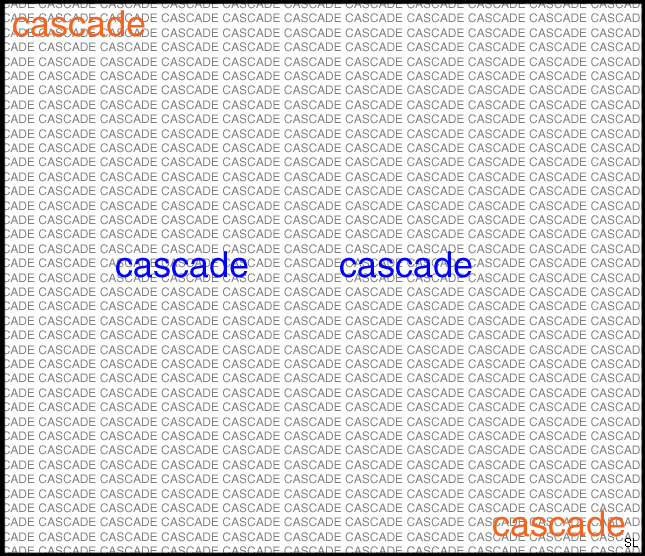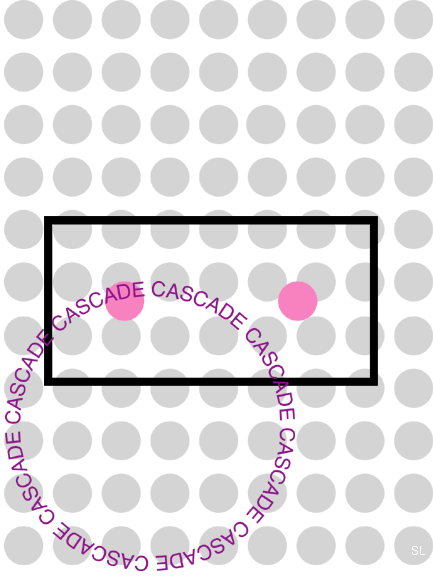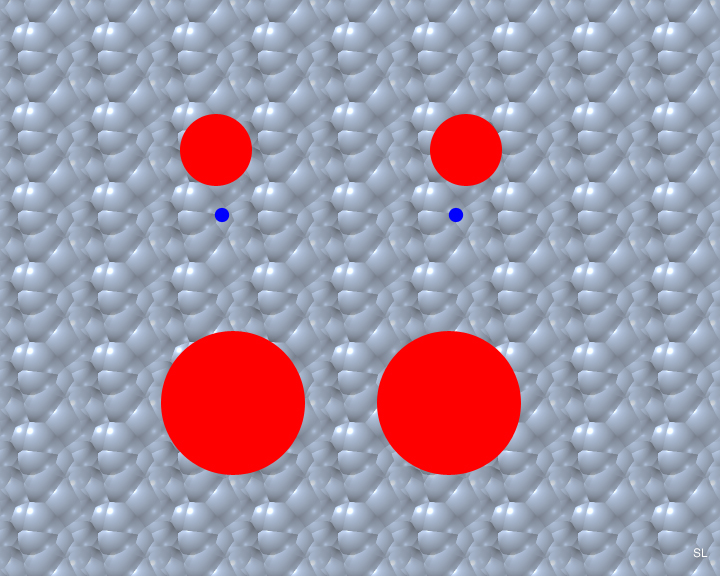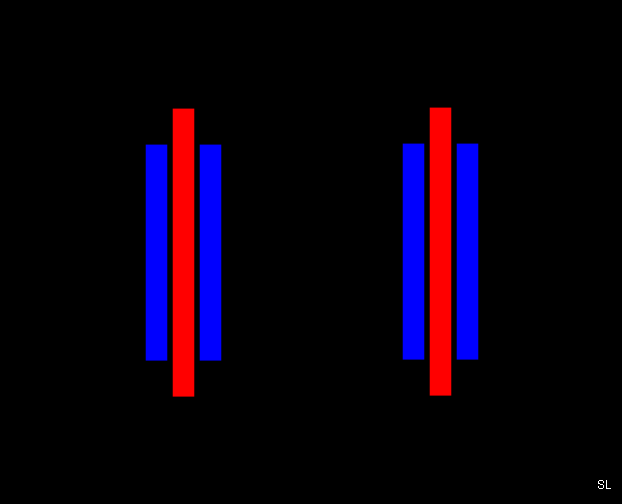MUSING ON PERCEPTIONFollowing are some thoughts about two unrelated 3D phenomena. One is the perception of depth as a result of staring at repeating patterns, the other phenomenon is the perception of advancing and receding colors. The "Wall Paper" effect, as it is known, occurs when staring at a repeating design, hence the name. It is possible to see the effect if one is able to free-view in parallel a repeating pattern. The effect does not depend on the colors of the pattern, nor their shape, as is obvious in illustration #1 where the repeating pattern is made from the words "cascade" which are gray color.
Illustration # 1 The pattern appears to be floating. Whether it floats in front of, or behind another object, depends on several factors, but mainly on the relative position of the pattern in relation to its surroundings and the relative position of other shapes "inside" the pattern. You can see some variations of the effect in illustration #3. If you parallel-free-view the background made up of large gray circles, you may see the other patterns floating in front of the background, but if you free-view cross-eyed the two pink circles, the background floats in front of the circles. If the circles are free-viewed in parallel, the background floats in the back. Illustration #4 is just another variation of the same thing.
Illustration # 3
Illustration # 4 To illustrate how the relative position of objects within the same frame of the background are affected by their relative position, look at illustration #2. Free-viewing the background in parallel puts the other objects in front of it. Free-viewing in parallel the large red circles puts those and the small blue circles in front of the background but places the small red circles behind the background. You can experiment to see what happens when you cross-view the different circles.
Why does this happen? I will venture the following explanation: When you free-view in parallel a repeating pattern, you are NOT seeing one picture, you are actually seeing two identical pictures – one with each eye. Depending on the surroundings, your brain interprets this fused image as (most likely) a distant image since when you stare at a distant object, you relax your eye muscles (parallel free-viewing) and thus tricking the brain to "think" that you are looking at a far object from two different angles. Why do you see two pictures? Because each eye looks at a complete but a single small pattern in front and directly of that eye. When you pan your eyes, you are basically switching "one segment of two images" to the direction of movement and retaining the relative distance between each object of the segment. The more accurate the objects of the pattern are, the smoother the panning. There are two phenomena associated with color, of interest to this discussion. One is chromatic aberration, the other is over-stimulation of the retinas. If two shapes with colors of equal intensity, but at opposite ends of the spectrum are placed very close side by side and viewed with naked eyes, there is a shimmering effect as a result of the proximity of the colors. When these colored shapes are viewed through a stereoscope we add another factor, that of different focusing distance for different colors. Look at the stereocard in illustration #5. The sign on the train that says "K103fm" is flat but when seen through a stereoscope the blue letters are in front of the black background while the red letters are behind it. This phenomenon is known as chromatic aberration and is caused because of the different wavelengths of blue and red light. An even more pronounced effect can be seen in illustration #6.
Illustration # 5
Illustration # 6
This effect has been used by artists using illustrations with predominantly red and blue colors. By using special glasses one can see some sort of depth in the images. Although these are not stereoscopic images, they appear to float. This happens because one looks at these pictures, through glasses made of diffraction grating material which disperses the light just as a glass prism does, and so focuses the blues and the reds at slightly different distances. Chromatic aberration is a major problem in lenses. Simple lenses cannot bring to focus the full spectrum at one sharp point, placing the blues closer than the reds. One can see this phenomenon while looking at black and white images through a simple magnifying glass. The image edges exhibit thin bands of color caused by chromatic aberration. To correct this, more expensive optical devices use achromatic lenses, which are made by sandwiching two pieces of glass with different refractive index, thus eliminating most of the problem. A prism disperses white light into its components ranging from deep red to deep violet.
Compare the lens in illustration #7 with the prism below it, and see the similarities between the two. Because a simple lens acts as two prisms base to base, it cannot focus white light onto a single point, causing chromatic aberration. An easy way to remember the order of the colors of the rainbow is to use the following mnemonic of a fictitious name: ROY G. BIV (Red Orange Yellow Green Blue Indigo Violet) SL |






